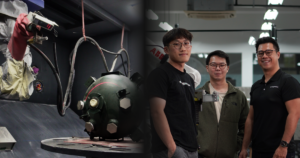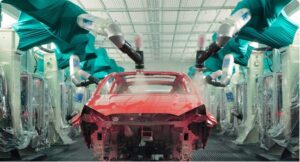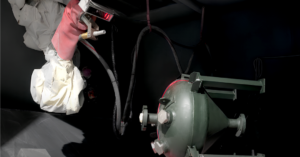table of contents
- Heading 1
- Heading 1
- Heading 1
share this
Spraying and shot peening are processes used to increase the life span of metal parts in machinery. This procedure is commonly used in the aerospace and marine industry where metal structures need to cope with harsh environmental conditions. As companies try to maximize profits, industrial automation for spraying and shot peening that helps minimize repair costs have gained popularity.
Industrial Robots for Surface Treatment: Spraying and Shot Peening
Spraying and Shot Peening
Spraying and shot peening helps to prevent breakdowns caused by wear and tear by enhancing the prevailing metal structures. However, there is a distinct difference between the two processes. Spraying enhances the structure by adding a coating of a material such as metals or ceramics, covering the original surface (Robots Done Right, 2019). On the other hand, shot peening – otherwise known as shot blasting – uses small spherical shots to bombard the surface and dimple the metal (Engineered Abrasives, n.d.). A layer of overlapping dimples results in compression stress throughout the surface and strengthens the metal (Engineered Abrasives, n.d.). There is no additional coating of other materials in shot peening.
Figure 1: Shot Peening Image by Shutterstock
Spraying Case Study 1: Baton LLC
Problem
The quality of the application affects the effectiveness of the spray coating. The applicators’ skill and stand-off distance need to be optimal (Schellinck, 2021). However, manual spraying causes respiratory health problems for workers as they inhale toxic particles (Keyes, 2019).
Conventional overhead nozzles used cause uneven application on surfaces. Firstly, objects not placed uniformly can cause spray distribution to vary as the distance of the object to the nozzle determines the amount of material coating the object. Secondly, certain areas of the object will be missed when objects are placed outside of their pre-determined position.
This is a direct result of the nozzle being in a fixed position, making it unable to move to accommodate this change. Thus, quality is compromised as coatings are inconsistent. Hence, despite automation, results may still be undesirable (Schellinck, 2021).

Figure 2: Automated Spraying on Aeroplane Exterior Image by Xyrec
Solution
Dakswan Automation Systems Inc specialises in Electrical Control and Robot Systems Design (Dakswan, 2021). They helped Baton LLC install the Kawasaki RS080N that helped to cut costs and streamline operations.
Dakswan also customised an end-of-arm tool in order to hold the same paint system that Baton LLC employed. Hence, the robotic arm is able to replace workers, delivering more consistent paint applications at the same speed.
Eliminating human interference has enhanced productivity by an average of 2.5 hours weekly and removed workers from the harmful work environment (Keyes, 2019). Furthermore, the minimal alterations to the current process make the integration of the robotic arm smooth (Keyes, 2019).

Figure 3: Automated Spraying Robotic Arm Image by Spraying Systems Co.
Spraying Case Study 2: Lockheed Martin Aeronautics case study
Problem
In the aerospace industry, there are strict radar cross-section and weight requirements for aircraft (Seegmiller, 2009). On top of that, the aircraft needs to withstand the harsh environment it is placed in. As such, the body of the plane receives a stealth coating with accuracy measuring a thousandth of an inch (Seegmiller, 2009).
This is especially so for military aircraft like the F-35. Conventional spraying techniques are insufficient in ensuring consistent thickness throughout the surface of the aircraft.
Solution
Lockheed Martin Aeronautics is a company that has designed, built and sustained military aircraft. With the abovementioned restrictions, the company has created a Robotics Aircraft Finishing System (RAFS) to meet the stringent weight requirements (Seegmiller, 2009).
Thus, the RAFS combines hardware design and coating process development to create a system that ensures precise coating thickness. The Fanuc R2000iA material handling robot delivers the paint. Additionally, with the scale of the project being relatively large, it was important for the arm to be able to support large end effectors. Longer end effectors are required to achieve the best stand-off distance as it contributes to the precision of the coating (Seegmiller, 2009). Furthermore, a single Fanuc R-J3iB controller controls the robotic arm.
This allows for uninterrupted coordination and removes workers from the harmful work environment.

Figure 4: Spraying using Industrial Robot Image by Product Finishing
Shot Peening Case Study: Manufacturing Technology Centre (MTC)
Problem
MTC’s client – Sandwell – is a specialist for surface processing and coating that deploys advanced multi-axis shot-peening machines (Manufacturing Technology Centre [MTC], n.d.). Sandwell’s customers require quick turnarounds for parts while maintaining high quality. Since these parts are often the final step in the production process, it is essential for the response to be speedy (MTC, n.d.).

Figure 5: Shot Peening with Robotic Arm Image by Clemco Denmark
Solution
MTC works closely with Sandwell to implement a robotic system that can eliminate time-consuming coding processes. The system geometrically scans parts to produce a CAD model (MTC, n.d.). To further enhance productivity, the scan automatically determines the robot’s path. Accordingly, the efficiency of shot-peening increases as response times are shortened and energy resources are conserved (MTC, n.d.).

Figure 5: Shot Peening with Robotic Arm Image by Clemco Denmark
Using Augmentus for Surface Treatment Applications
The Augmentus Platform eliminates the need for coding and robot teaching even for complex surface treatment applications. Our technology allows users to accurately 3D scan parts and automatically generate optimized robot path planning. Therefore, companies are able to easily and rapidly deploy robots without the need for robotic experts, even in a high-mix production environment.

About Augmentus
Augmentus pioneers industry-leading robotic technologies that enable easy and rapid robotic automation, enabling anyone, even those with no robotic experience, to program dynamic industrial robots in minutes. Our proprietary technology incorporates algorithms to enable fully automated robot path generation and an intuitive graphical interface that eliminates the need for coding and CAD files in robot teaching. Companies using Augmentus have experienced up to 70% cost reduction and 17 times faster deployments across a wide variety of applications, such as spraying, palletizing, welding, and inspections. Augmentus ushers in a new era of human-machine interface, democratizing robotic automation.
References
- Dakswan. (2021, May 20). Home. DAKSWAN Automation Systems, Inc. https://dakswan.com/
- Engineered Abrasives. (n.d.). What is Shot Peening – How Does Shot Peening Work | Engineered Abrasives®. https://www.engineeredabrasives.com/what-is-shot-peening.html
- Keyes, L. (2019, May 22). Case Study: Consistent Spraying in an Unfriendly Environment Using Kawasaki Robot. Automate. https://www.automate.org/case-studies/case-study-consistent-spraying-in-an-unfriendly-environment-using-kawasaki-robot
- Manufacturing Technology Centre. (n.d.). New software improves the accuracy of automated shot-peening process. https://www.the-mtc.org/case-studies/new-software-improves-the-accuracy-of-automated-shot-peening-process/
- Robots Done Right. (2019, May 15). Thermal Spray Robots. https://robotsdoneright.com/applications/thermal-spray-robots.html
- Schellinck, S. (2021, September 8). HOW A ROBOTIC SPRAYING SYSTEM CAN CHANGE SPRAY TECHNOLOGY. Spraying Systems Co. https://www.spray.com/en-gb/blog/how-a-robotic-spraying-system-can-change-spray-technology
- Seegmiller, N. A., Bailiff, J. A., Franks, R. K. (2009) Precision Robotic Coating Application and Thickness Control Optimization for F-35 Final Finishes. Lockheed Martin Aeronautics Company. https://www.ri.cmu.edu/pub_files/2010/3/Seegmiller_SAE-2010_Precision_Robotic_Coating.pdf




